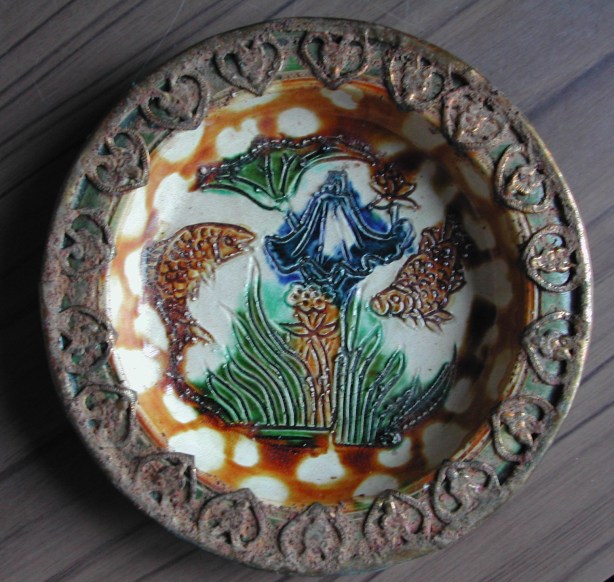I’ve spent many years working in public engagement with science. (For readers who are normal people, this is pretty much a high-falutin’ way of saying ‘getting scientists talking to other people’). People who work in public engagement are often thinky-talky kind of people, so there’s been a lot of conversations over the years about what public engagement is, and why we do it.
When people talk about WHY we do public engagement, they often talk about democracy and accountability, and I think that’s hugely important. They talk about some sorts of public engagement improving the science, because scientists are exposed to other stakeholders and ‘experts’. I think that’s important too.
But there’s something else I think is important, that we don’t talk about so much. I think public engagement is a chance for ideas to have sex.
I went travelling in China a few years ago. A guide at a museum in Xi’an, the ancient capital, pointed out the tri-colour glaze pottery from the Tang era (618-907 CE).
Before then Chinese potters only knew how to make two colours. Decorating pots with three colours was ground-breaking. Seeing these pots for the first time must have been a bit like seeing your first technicolour film.
The guide explained how tri-colour glaze came about. A wave of Persian emigrees in the 7th Century brought the secret of how to make a blue glaze. The Xi’an potters added that to the colours they could already make, and incorporated into it their art. Thus creating the golden age of Chinese pottery. In fact the Tang dynasty (influenced perhaps by the wave of immigrants from another advanced civilization) is generally regarded as a high point in Chinese culture.
New ideas don’t come from nowhere. They come from sticking together bits of old ideas in new and interesting ways.
The worst thing you can do for creativity and innovation is hang out with people just like yourself, who know the same things you do. Unfortunately, for various reasons, a lot of the time that’s what people do.
To my mind, a big part of the value of public engagement is in this mixing up of the ideas gene pool. You don’t only get that from scientists talking to ‘the public’ (whoever that is) of course. They can be talking to scientists in other fields, or other kinds of experts. Get chemists talking to chefs and who knows what can come out of it?
It can be doctors talking to historians. It can be policy-makers talking to grannies. It can be magicians talking to traffic planners as far as I’m concerned. In fact, maybe the more random the pairing the better. The key thing, for creativity, is getting people talking to people they wouldn’t normally talk to.
But let’s get real. It’s not quite as simple as just shoving the disparate together. You can’t just plunk a load of graffiti artists in a room with a bunch of actuaries and think they’ll get on like a house on fire. People need to find some sort of common ground. And they need to approach it open to the idea they could learn something interesting from each other.
So how do you make that happen? Well, to be truthful, I don’t know. But Tales from the River is an experiment in that direction. I think stories are a great way for people to connect on a human level. Everyone has a story. Everyone can relate to them. Humans are story-making animals.
We’re going to tell people stories, get them thinking in that playful, imaginative, mythic space. Then get them telling each other their stories – from folk tales, to personal reminiscences. Then we’re going to see what happens.
At the very least, we’ll entertain people for a couple of hours. And that in itself is not to be sniffed at.
And maybe some people will go away and have ideas they wouldn’t have otherwise. I don’t mean for curing cancer or ending war (although that would be nice). Maybe it’ll just help them understand why their sister is pissed off with them. Or give them an idea of a book to read, that they wouldn’t have otherwise. Or a different place to go on holiday.
But new ideas are good, they jog you out of your rut, help you see things differently, help you solve problems. There must be a million ways of getting people talking and their ideas shagging, that I don’t know about. If you know about good ones, then I’d love to hear them…


Hi Sophia – hear hear! Look forward to following Tales from the River for examples and ideas. For me, public engagement is not about “duty”, it’s about benefits to my research (and I’ve summarised some personal experience at http://bit.ly/NOzCVz ).
When it comes to getting ideas shagging, I’m a big fan of specifically targeting “retirees / life-long learners” in engagement activities (through networks such as University of the Third Age and Probus). It’s pretty arrogant to think that only fellow specialists in your field can have any insights of value for your work, and engagement is a way of “crowdsourcing” wider experience and perspectives.
I’ve found “retirees / life-long learners” to be a great constituency for that, even though my research is blue skies stuff, exploring the deep ocean. Audiences might include someone who had a career as an economist, or a lawyer, or an engineer, or a teacher, etc–it doesn’t really matter, they are all interested people with lifetimes of experience, who are not afraid to ask questions that cut to the quick of a topic.
The ideas often come from the questions that people ask when we’re talking about our work–thinking through the answers to those questions has sometimes led to a new perspective of an issue for me. So anything that helps us have a conversation is good, in my book.
Hi Jon,
Cheers, that’s a lovely example. Totally with you on learning from non-experts. You’ve made me even keener to make sure we get all different ages participating in Tales from the River.
Soph
Pingback: Why do we write?
Pingback: Would you like to talk about the Tweed? | Tales from the Tweed